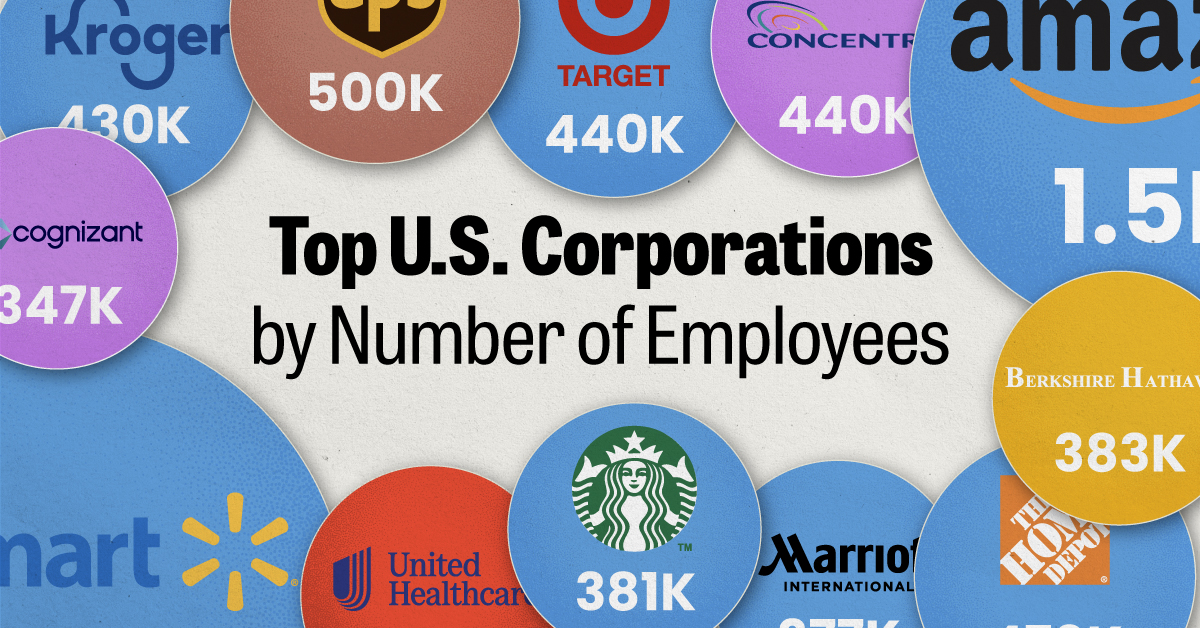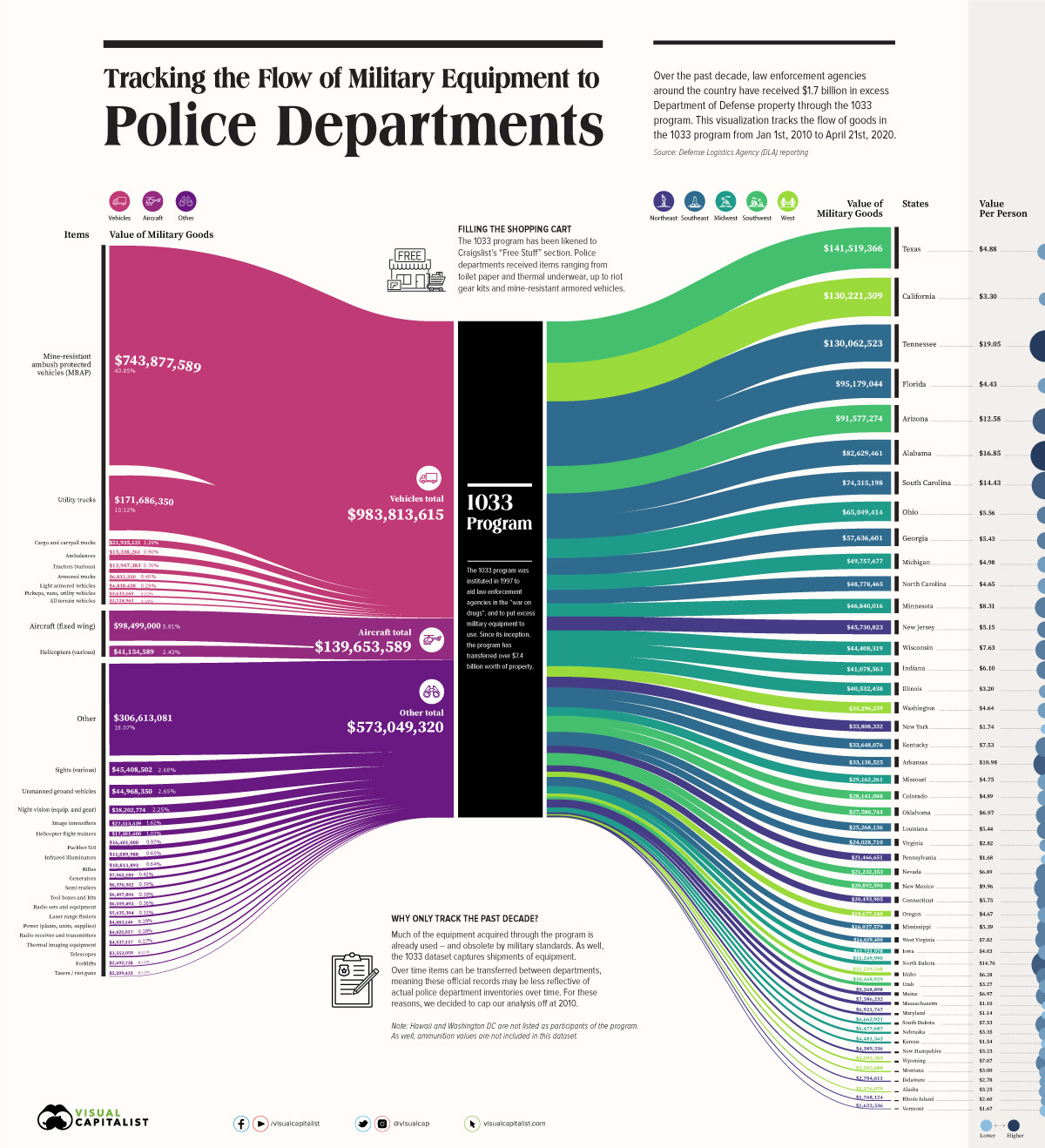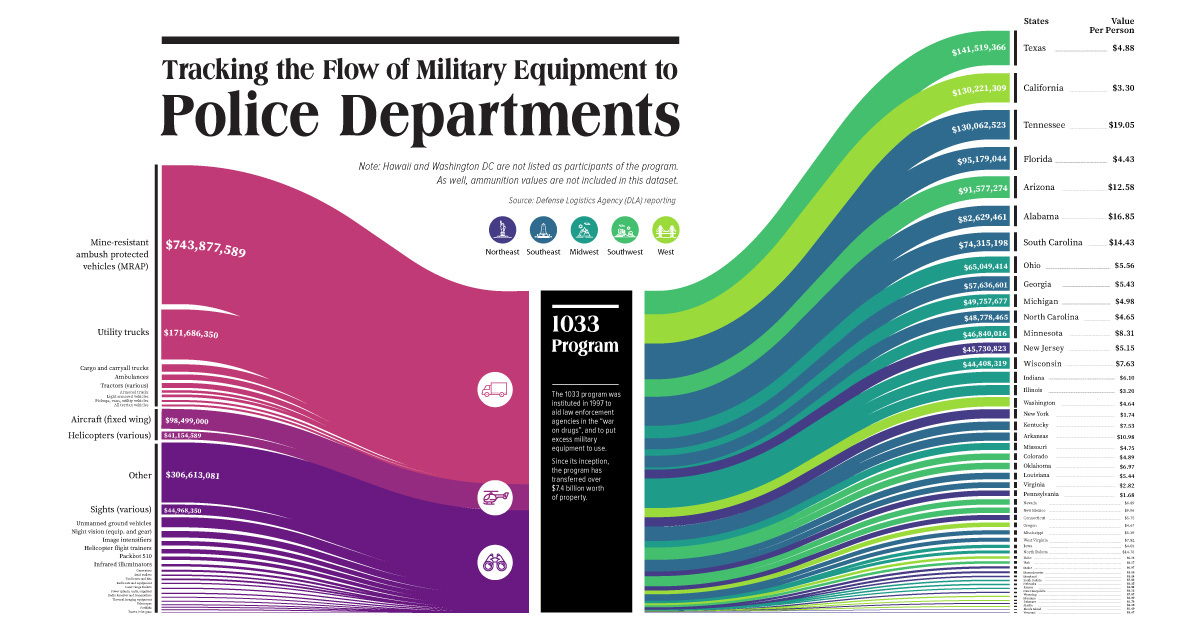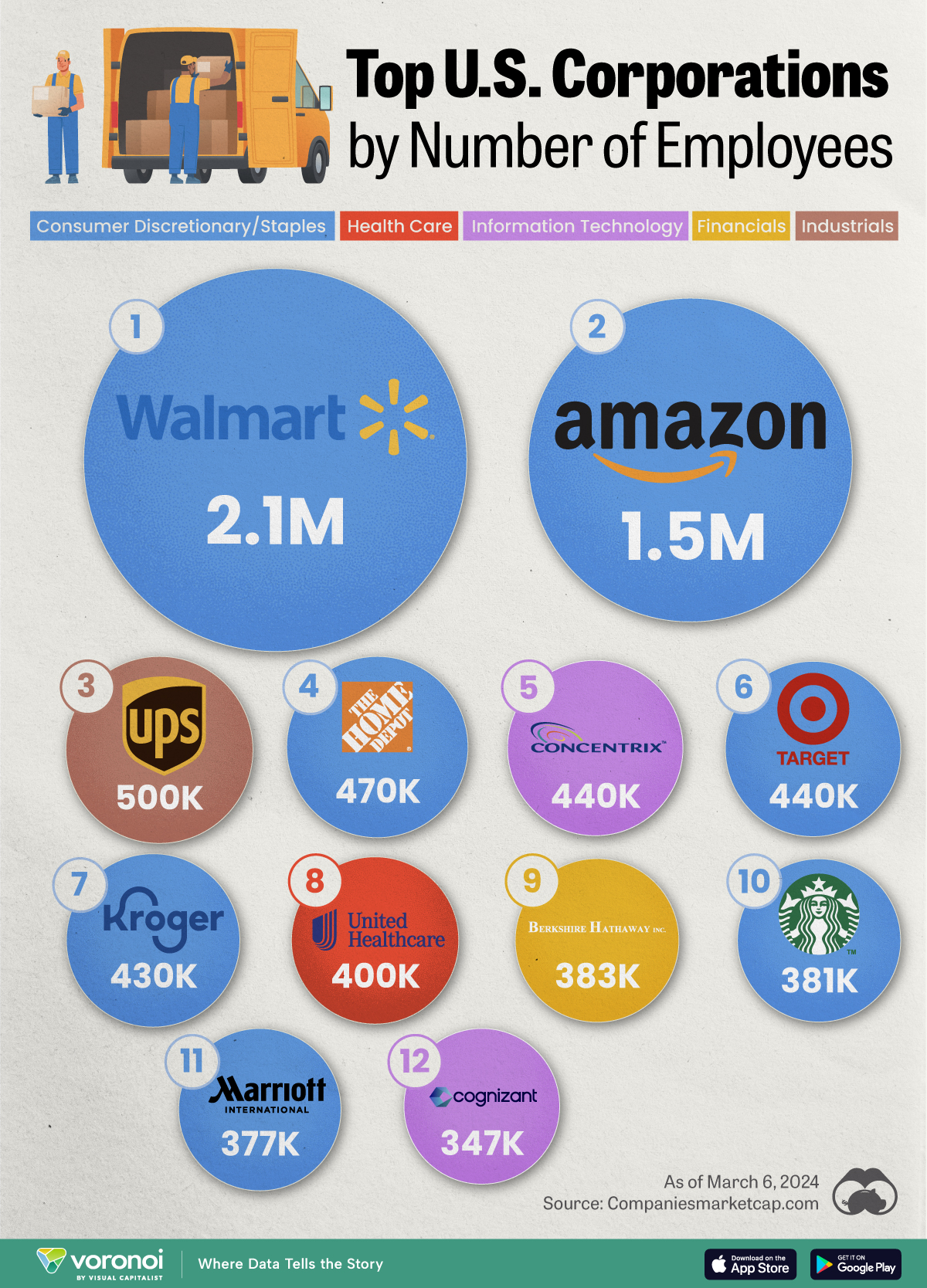United States
Charting the $1.7B Transfer of Military Equipment to Police Departments
View the full-size version of this infographic.
Charting the $1.7B Transfer of Military Equipment to Police Departments
View the full-size version of this infographic.
In the wake of countrywide protests surrounding the killing of George Floyd, questions around the militarization of police forces have taken center stage once again.
How did so many police departments across the United States end up with bomb-proof trucks and night vision goggles? Where are departments acquiring this equipment, and at what cost?
These questions and more are answered by data from the Defense Logistics Agency, which oversees the 1033 Program. The visualization above tracks the flow of military equipment to law enforcement over the past decade.
A note on the data: Much of the equipment acquired through the program is already used – and often obsolete by military standards. As well, the 1033 dataset captures shipments of equipment. Over time, items can be transferred between departments, meaning these official records may be less reflective of specific police department inventories as time goes on. For these reasons, we decided to cap our analysis to looking at the last decade (2010-2020) of transfers.
Free Military Surplus for Law Enforcement
The 1033 Program was conceived in the years following Operation Desert Storm, just as America’s violent crime rate was hitting an all-time high. During this era, America’s “war on drugs” and tough-on-crime political platforms provided the impetus for the militarization of police forces around the country.
The 1033 program has been likened to Craigslist’s “Free Stuff” section, and the comparison is apt. The mechanics of the program are relatively straightforward. Outdated military gear is transferred (at no cost) to state and local law enforcement agencies who go through the application process. The equipment is loaned to agencies, who are only responsible only for shipping and subsequent operating costs (e.g. fuel, spare parts).
Law enforcement agencies gain access to a vast array of military surplus, from office supplies and thermal underwear up to armored vehicles and multi-million dollar communications systems. Also included in the mix are medical supplies and gear to aid in search and rescue operations. Since the program’s inception, over $7.4 billion worth of property has been transferred.

One of the most popular items acquired by police departments is the Mine-Resistant Ambush Protected vehicle, or MRAP. Over the past decade, over 1,000 of these vehicles were transferred from the military to law enforcement agencies. This includes places like Monett, Missouri (population 9,000), which is on record as receiving two MRAP vehicles.
Night vision equipment is extremely popular as well. Items like goggles, scopes, and surveillance equipment – which can run thousands of dollars per unit – have been shipped to police departments around the country.
Of course, military surplus isn’t just about fancy vehicles and weaponry. The Meade County Sheriff’s Office in Kentucky is on record for ordering a single box of toilet paper just as COVID-19 was on the rise in that state.
Shipments at the State Level
Since the army is willing to part with excess equipment, cash-strapped police departments are happy to oblige. More than $1.7 billion of surplus has been transferred over to police around the country over the past decade.
The two biggest spenders, California and Texas, combined to acquire a total of $271 million in equipment, but looking at things on a per capita basis helps to show the states that were most enthusiastic about the 1033 Program in more relative terms.
| State | Value of equipment (2010-2020) | Value of equipment per capita |
|---|---|---|
| Texas | $141,519,366 | $4.88 |
| California | $130,221,309 | $3.30 |
| Tennessee | $130,062,523 | $19.05 |
| Florida | $95,179,044 | $4.43 |
| Arizona | $91,577,274 | $12.58 |
| Alabama | $82,629,461 | $16.85 |
| South Carolina | $74,315,198 | $14.43 |
| Ohio | $65,049,414 | $5.56 |
| Georgia | $57,636,601 | $5.43 |
| Michigan | $49,757,677 | $4.98 |
| North Carolina | $48,778,465 | $4.65 |
| Minnesota | $46,840,016 | $8.31 |
| New Jersey | $45,730,823 | $5.15 |
| Wisconsin | $44,408,319 | $7.63 |
| Indiana | $41,078,563 | $6.10 |
| Illinois | $40,532,438 | $3.20 |
| Washington | $35,296,239 | $4.64 |
| New York | $33,808,332 | $1.74 |
| Kentucky | $33,648,076 | $7.53 |
| Arkansas | $33,138,525 | $10.98 |
| Missouri | $29,162,261 | $4.75 |
| Colorado | $28,141,088 | $4.89 |
| Oklahoma | $27,580,744 | $6.97 |
| Louisiana | $25,268,136 | $5.44 |
| Virginia | $24,028,710 | $2.82 |
| Pennsylvania | $21,466,651 | $1.68 |
| Nevada | $21,232,353 | $6.89 |
| New Mexico | $20,892,590 | $9.96 |
| Connecticut | $20,493,905 | $5.75 |
| Oregon | $19,677,189 | $4.67 |
| Mississippi | $16,027,579 | $5.39 |
| West Virginia | $14,019,400 | $7.82 |
| Iowa | $12,721,978 | $4.03 |
| North Dakota | $11,249,990 | $14.76 |
| Idaho | $11,219,248 | $6.28 |
| Utah | $10,468,929 | $3.27 |
| Maine | $9,368,898 | $6.97 |
| Massachusetts | $7,586,232 | $1.10 |
| Maryland | $6,921,747 | $1.14 |
| South Dakota | $6,662,921 | $7.53 |
| Nebraska | $6,477,687 | $3.35 |
| Kansas | $4,481,543 | $1.54 |
| New Hampshire | $4,389,536 | $3.23 |
| Wyoming | $4,092,509 | $7.07 |
| Montana | $3,205,688 | $3.00 |
| Delaware | $2,704,611 | $2.78 |
| Alaska | $2,376,079 | $3.25 |
| Rhode Island | $1,768,124 | $1.67 |
| Vermont | $1,622,536 | $2.60 |
Tennessee had by far the highest spending considering its population, with police departments in the state acquiring $20 worth of equipment per person. With the exception of Arizona, all the states that rank highly in that metric have per capita police spending that sits well below the U.S. average.
On the flip side, New York came in at a fraction of that amount, acquiring only $1.74 worth of equipment for every person in the state. Of course, it’s worth noting that New York had the highest police expenditure in the country (after Washington DC).
Who got the Goods?
Not surprisingly, state-level law enforcement agencies topped the list. For example, the Arizona Department of Public Safety received multiple airplanes valued at $17 million per unit. California’s highway patrol received the most expensive single item on the list – a $22 million aircraft.
For a more local perspective, here’s a look at the top 20 police departments by value of military equipment acquired:
| Law Enforcement Agency (Exc. state) | State | Value of Equipment Acquired |
|---|---|---|
| Houston Police Department | TX | $11,682,951 |
| Las Vegas Metro Police Department | NV | $8,995,931 |
| Washington County Sheriff's Office | TN | $7,501,075 |
| Columbus Division of Police | OH | $6,885,949 |
| Ventura County Sheriff's Office | CA | $6,605,678 |
| Columbus County Sheriff's Office | NC | $6,596,927 |
| Sacramento County Sheriff's Department | CA | $6,142,009 |
| Santa Barbara County Sheriff's Office | CA | $5,902,198 |
| Hocking County Sheriff's Office | OH | $5,865,008 |
| Jackson Police Department | MS | $5,823,634 |
| Orange County Sheriff's Department | CA | $5,802,758 |
| Lawrenceburg Police Department | TN | $5,543,166 |
| Sherburne County Sheriff's Office | MN | $5,194,238 |
| Kirklin Police Department | IN | $5,014,748 |
| Los Angeles Country Sheriff's Department | CA | $4,840,970 |
| King Country Sheriff's Department | WA | $4,618,686 |
| Pinal Country Sheriff's Department | AZ | $4,305,849 |
| Martin County Sheriff's Office | FL | $4,179,645 |
| Kane County Sheriff's Office | IL | $4,006,465 |
| Cottage Grove Police Department | MN | $3,941,606 |
On its own, Houston police department received as much as the bottom five states combined. Nearly 400 other police departments also broke the $1 million barrier, and over 2,026 departments around the country received over $100,000 in goods.
Markets
Ranked: The Largest U.S. Corporations by Number of Employees
We visualized the top U.S. companies by employees, revealing the massive scale of retailers like Walmart, Target, and Home Depot.

The Largest U.S. Corporations by Number of Employees
This was originally posted on our Voronoi app. Download the app for free on Apple or Android and discover incredible data-driven charts from a variety of trusted sources.
Revenue and profit are common measures for measuring the size of a business, but what about employee headcount?
To see how big companies have become from a human perspective, we’ve visualized the top U.S. companies by employees. These figures come from companiesmarketcap.com, and were accessed in March 2024. Note that this ranking includes publicly-traded companies only.
Data and Highlights
The data we used to create this list of largest U.S. corporations by number of employees can be found in the table below.
| Company | Sector | Number of Employees |
|---|---|---|
| Walmart | Consumer Staples | 2,100,000 |
| Amazon | Consumer Discretionary | 1,500,000 |
| UPS | Industrials | 500,000 |
| Home Depot | Consumer Discretionary | 470,000 |
| Concentrix | Information Technology | 440,000 |
| Target | Consumer Staples | 440,000 |
| Kroger | Consumer Staples | 430,000 |
| UnitedHealth | Health Care | 400,000 |
| Berkshire Hathaway | Financials | 383,000 |
| Starbucks | Consumer Discretionary | 381,000 |
| Marriott International | Consumer Discretionary | 377,000 |
| Cognizant | Information Technology | 346,600 |
Retail and Logistics Top the List
Companies like Walmart, Target, and Kroger have a massive headcount due to having many locations spread across the country, which require everything from cashiers to IT professionals.
Moving goods around the world is also highly labor intensive, explaining why UPS has half a million employees globally.
Below the Radar?
Two companies that rank among the largest U.S. corporations by employees which may be less familiar to the public include Concentrix and Cognizant. Both of these companies are B2B brands, meaning they primarily work with other companies rather than consumers. This contrasts with brands like Amazon or Home Depot, which are much more visible among average consumers.
A Note on Berkshire Hathaway
Warren Buffett’s company doesn’t directly employ 383,000 people. This headcount actually includes the employees of the firm’s many subsidiaries, such as GEICO (insurance), Dairy Queen (retail), and Duracell (batteries).
If you’re curious to see how Buffett’s empire has grown over the years, check out this animated graphic that visualizes the growth of Berkshire Hathaway’s portfolio from 1994 to 2022.
-

 Green2 weeks ago
Green2 weeks agoRanked: Top Countries by Total Forest Loss Since 2001
-

 Travel1 week ago
Travel1 week agoRanked: The World’s Top Flight Routes, by Revenue
-

 Technology1 week ago
Technology1 week agoRanked: Semiconductor Companies by Industry Revenue Share
-

 Money2 weeks ago
Money2 weeks agoWhich States Have the Highest Minimum Wage in America?
-

 Real Estate2 weeks ago
Real Estate2 weeks agoRanked: The Most Valuable Housing Markets in America
-

 Markets2 weeks ago
Markets2 weeks agoCharted: Big Four Market Share by S&P 500 Audits
-

 AI2 weeks ago
AI2 weeks agoThe Stock Performance of U.S. Chipmakers So Far in 2024
-

 Automotive2 weeks ago
Automotive2 weeks agoAlmost Every EV Stock is Down After Q1 2024




